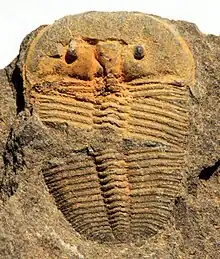Aulacopleura
Aulacopleura is a genus of proetid trilobite[1] that lived from the Middle Ordovician to the Middle Devonian. Some authors may classify this group as subgenus Otarion (Aulacopleura).[2] The cephalon is semicircular or semielliptical, with border and preglabellar field. The glabella is short, with or without defined eye ridges connecting it with eyes of variable size. Spines at the rear outer corners of the cephalon (or genal spines) are present, typically reaching back to the 2nd to 4th thorax segment. The 'palate' (or hypostome) is not connected to the dorsal shield of the cephalon (or natant). The cephalon is pitted, or has small tubercles. The thorax has up to 22 segments. The pleural ends are usually rounded. The pygidium is small (micropygous), with an even margin. A. koninckii had a modern type of compound eye.[3]
| Aulacopleura Temporal range: | |
|---|---|
 | |
| Aulacopleura koninckii, Kosov u Berouna, Czech Republic | |
| Scientific classification | |
| Domain: | Eukaryota |
| Kingdom: | Animalia |
| Phylum: | Arthropoda |
| Class: | †Trilobita |
| Order: | †Proetida |
| Family: | †Aulacopleuridae |
| Genus: | †Aulacopleura Hawle & Corda, 1847 |
| Type species | |
| †Arethusa koninckii Barrande, 1846 | |
| Species | |
| |
| Synonyms | |
|
Arethusa Barrande, 1846 non De Montfort, 1808, Arethusina Barrande, 1852 | |
Taxonomy
Barrande described Arethusa koninckii in 1846. However, Arethusa was occupied since it was used by De Montfort in 1808 for a foram protist. Barrande tried to correct this by proposing Arethusina as a replacement, but by that time that Hawle and Corda had already suggested Aulacopleura in 1847, which is thus the senior available name.[4][5]
Distribution
- A. andersoni Adrian & Chatterton, 1995 - from the Lower Silurian of Canada (Late Telychian, Upper Whittaker Formation, Mackenzie Mountains)[6]
- A. koninckii[7][8][9][10][11] is known from the Middle Silurian of the Czech Republic (Wenlockian, Liten Formation, Bohemia).[7]
- A. krizi Snajdr, 1975 - Lower Silurian Bohemia (Želkovice formation, Beroun region, Central Bohemia)[12][13]
- A. letmathensis has been found in the Middle Devonian of Germany (Givetian).
- A. pogsoni was collected from Lower Silurian of Australia (late Llandovery, upper Cotton Formation, near Forbes, New South Wales).[6]
- A. wulongensis occurs in the Lower Silurian of China (Llandovery, Sichuan).)[7]
See also
References
- Sam M. Gon III. "Trilobite info". www.trilobites.info.
- Fossilworks: †Aulacopleura Hawle and Corda 1847 (trilobite)
- Schoenemann, Brigitte; Clarkson, Euan N. K. (2020-08-13). "Insights into a 429-million-year-old compound eye". Scientific Reports. Springer Science and Business Media LLC. 10 (1). doi:10.1038/s41598-020-69219-0. ISSN 2045-2322. PMC 7426942.
- Moore, Raymond C., ed. (1959). Treatise on Invertebrate Paleontology [Part O - Arthropoda 1 (Arthropoda General Features, Protarthropoda, Euarthropoda General Features, Trilobitomorpha)]. Geological Society of America and University of Kansas Press.
- B. W. Hayward: Arethusa Montfort, 1808 †, on: World Foraminifera Database, marinespecies.org, Flanders Marine Institute
- Edgecombe, G.D.; Sherwin, L. (2001). "Early Silurian (Llandovery) trilobites from the Cotton Formation, near Forbes, New South Wales, Australia". Alcheringa: An Australasian Journal of Palaeontology. 25 (1): 87–105). doi:10.1080/03115510108619215. S2CID 128404133.
- Hong, Paul S.; Hughes, Nigel C.; Sheets, H. David (2014). "Size, shape, and systematics of the Silurian trilobite Aulacopleura koninckii". Journal of Paleontology. Cambridge University Press (CUP). 88 (6): 1120–1138. doi:10.1666/13-142. ISSN 0022-3360.
- Schoenemann, Brigitte; Clarkson, Euan N. K. (2020-08-13). "Insights into a 429-million-year-old compound eye". Scientific Reports. Springer Science and Business Media LLC. 10 (1). doi:10.1038/s41598-020-69219-0. ISSN 2045-2322. PMC 7426942.
- Marshall, Michael (2020-08-13). "Trilobites living 429 million years ago had eyes like modern insects". New Scientist.
- Fusco, Giuseppe; Hong, Paul S.; Hughes, Nigel C. (2016-05-06). "Axial growth gradients across the postprotaspid ontogeny of the Silurian trilobite Aulacopleura koninckii". Paleobiology. Cambridge University Press (CUP). 42 (3): 426–438. doi:10.1017/pab.2016.5. ISSN 0094-8373.
- Anderson, Natali (2020-08-17). "Silurian Trilobite Had Modern Type of Compound Eye - Paleontology". Sci.News.
- Šnajdr, Milan. New Trilobita from the Llandovery at Hýskov in the Beroun area, Central Bohemia (Czech). In: Vestník Ústredního Ústavu geologického 50(5). Praha, 1975. PP. 311-316. Pascal Francis (cnrs)
- BioLib: Aulacopleura krizi Šnajdr, 1975†